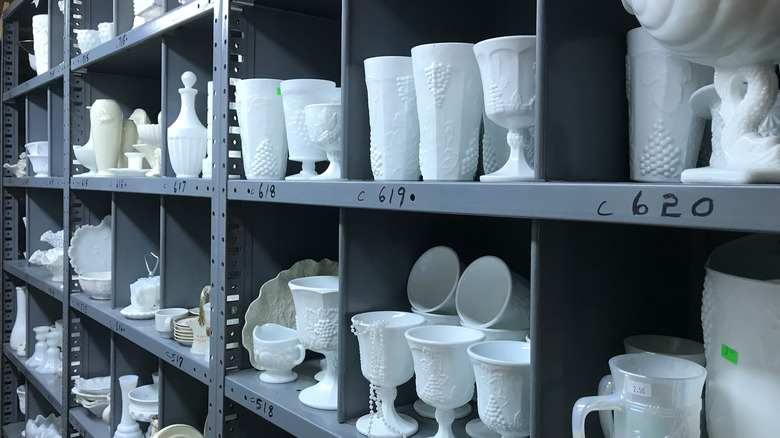The Little-Known Trick That Makes It Easy To Tell If Your Thrifted Milk Glass Is Vintage
"Milk glass" is the term for opaque white glass objects. They are typically covered in lovely patterns like grape leaves and come in the form of tableware, vases, candy dishes, cake stands, candlesticks, and more. While it's been around since at least the 1500s, milk glass production in the United States didn't kick off until the 19th century. It quickly gained popularity as a less expensive alternative to porcelain.
Milk glass continued to make a splash in the United States and England through the 1980s. Compared to other vintage drinkware, milk glass is relatively easy to find to this day. That said, it could be a valuable glass item you shouldn't pass up if you see it at the thrift store. Most milk glass isn't worth more than the enjoyment it brings, but vintage milk glass can be valuable. Alas, at first glance, it can be impossible to tell the difference between the modern and vintage pieces. For this reason, even highly collectible milk glass is often donated by unsuspecting owners.
If you want to get a better sense of when your thrifted milk glass was produced, you could wait for "Antiques Roadshow" to come to your town — or you could perform a simple trick. Hold your milk glass up to the sun. If your glass produces a colorful ring of reds, greens, and blues, then it was made with iridized salts and made before 1960. This iridescent ring is known as the "ring of fire."
Should you start collecting milk glass?
There are other ways to determine the age or value of a piece of milk glass besides looking for the "ring of fire." Some have the manufacturer listed on the bottom, which could reveal when it was made. Some collectors prefer the mid-century pieces, while others stick to the Victorian era, but both time periods are highly collectible. Colored milk glasses in shades of pink, blue, brown, and yellow that were popular in the 1950s can be valuable because they are harder to find.
You may look at the low price of some milk glass products and think it's not worth collecting. However, the current affordability makes it the perfect time to start. You can grow a large collection with little strain on your bank account, and you may come across some real antiques along the way. Even now, small vintage pieces are listed on eBay and Etsy for anywhere from $15 to $80, and milk glass lamps are listed for several hundred dollars.. If you find thrifted milk glass for only a couple of dollars a piece, that's a pretty good return on investment. You can also visit the National Milk Glass Collectors Society and check out their photo galleries of rare and collectible pieces. But ultimately, you should only collect this common thrift store item if you find it beautiful and will enjoy your collection whether it makes money — or not.
